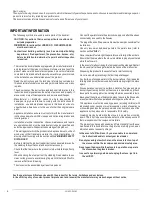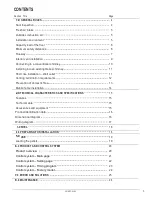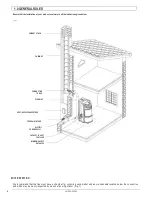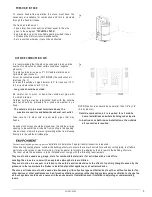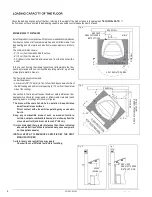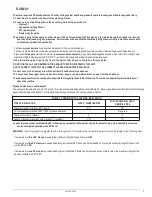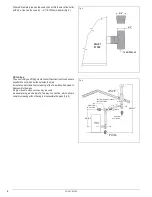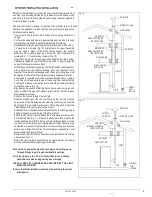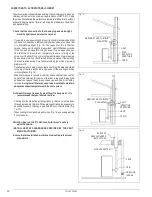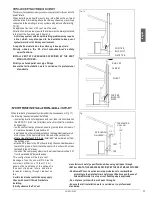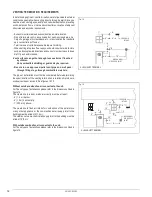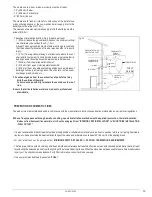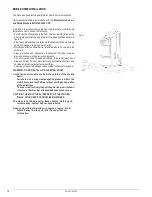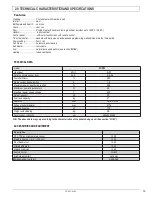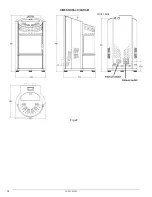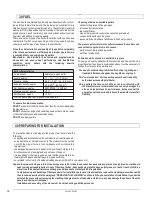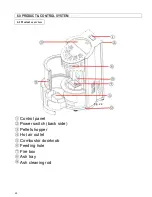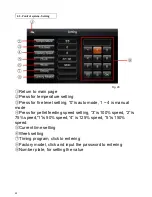
2018PC-03/03
9
This kind of installation provides the natural draft that results from
a vertical rise avoiding smoke being released into the house when
electricityto the unit isinterrupted while burningor smolderingpellets
remainsintheburngrate.
General vent layout is shown in figure and the procedure is as follows:
Position the appliance in desired location according to appliance
installation requirements.
- Use a plumb line to determine location of PL Vent penetration of
ceiling.
- Cut hole in ceiling and frame to appropriate opening size. Framing
materialshallbethesameasthatofadjacentjoistmaterial.
- InstallBlackCeilingSupportfrombelowjoistlevelandfastenwith4–
1.5” spiral nails or screws (Fig. 10). Alternatively, a Support Assembly
may be used in place of the black ceiling support the support
assembly fits to ceiling opening from below and is fastened to
joistswith4 - 1.5”spiralnailsorscrews(Fig.10).
- Insert first Vent section through Support and tighten the clamp screw.
Additionally fasten the vent with four screw (max ½” long) through the
supportcollarandintotheventskin.
- Install the vent section(s) atop the first.Twistlock sections together
with a clock-wise turn. Before twisting, push vent sections firmly
together for proper lock barb engagement. Enough twisting force must
beappliedtoensurethatthecollarswillcompressgasketmaterial.
- Firestops are required where the vent penetrates a floor or ceiling.
Cut a hole of the appropriate size in the ceiling/floor and install the
Firestopfromaboveorbelowthejoist.FastentheFirestopwithnails
through the corners (Fig. 10).
- Elbows may be used to offset the Vent as necessary to jog around
joists or rafters. Keep use of elbows to a minimum as they reduce
draftscapacityofavent.
- Continue the Vent up through the roof line.
- Slide the Flashing over the Vent until it sits on the roof line. Slip the
upper side of the Flashing base under the roof shingles. Nail the
flashing to the roof with a minimum of 8 roofing nails. Seals the
Flashing base with appropriate roofing mastic.
- SlidetheStormCollardowntheVentuntilitsitsontheflashing.Apply
abeadofsiliconearoundthetopoftheStormCollar.
- Extend the PLVent at least 12”above the roof line and terminate with a
PL listed Rain Cap (Fig. 11). If theVent extends more than 6’ above the
roof penetration, Roof Brace Poles and a Roof Brace Band must be
used to provide lateral support. In geographical regions experiencing
sustained low ambient temperature is recommended to enclose
exterior vents below the roof line.This help reduce condensation, soot
accumulation, and poordrafting.
- SettheRainCapontothe topVentsectionandtwist lockitto thetop
Ventsection(Fig.11).
- Where the vent system penetrates the air/vapour barrier, the barrier
mustbesealedtotheceilingsupportorfirestop.
Be sure to use approved pellet vent pipe and ceiling pass-
through fittings togo through combustible ceilings.
Strictly observe the PL Vent manufacturer’s safety
specifications when using ceiling pass through.
INSTALL VENT AT CLEARANCES SPECIFIED BY THE VENT
MANUFACTURER.
Ensure that all installation work is carried out to professional
standards.
Fig.10
RAINCAP
STORM COLLAR
FLASHING
SEE VENT
MANUFACTURER'S
INSTRUCTIONS
SEE VENT
MANUFACTURER'S
INSTRUCTIONS
ENCLOSURE
FIRESTOP
BLACK CEILING
SUPPORT
VENT
TEE
FRESH
AIR
INTAKE
Fig.11
RAINCAP
12" MIN
TOROOF
STORM COLLAR
FLASHING
SEE VENT
MANUFACTURER'S
INSTRUCTIONS
SUPPORT
VENT SECTION
VENT
TEE
FRESH
AIR
INTAKE
En
gl
ish


